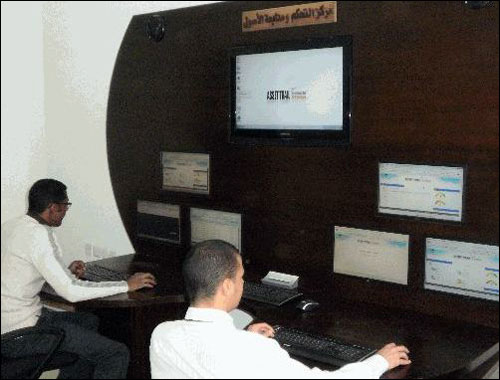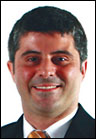For Najran University, with 21 campuses located in two Saudi Arabian cities—Najran and Sharoura—located 180 miles apart, tracking assets is a complex task. Collectively, the campuses have 33 administrative and teaching buildings with 13 colleges, and the various assets—which include furniture, lab equipment, tools, scanners, computers and copiers—located throughout all of the many buildings must be tracked from a central department, following procedures required by the nation’s Ministry of Higher Education. Gaining visibility regarding each item’s location was difficult, however, when the department was dependent on written records of where an asset was initially sent. Paperwork-based tracking, combined with the university’s rapid expansion, allowed for errors.
Assets often went missing, the university reports, because they were either stolen or merely relocated to other staff members or departments, without that transfer being recorded. In fact, the school estimates that 5 percent of the yearly purchases were lost, on average, through shrinkage—a large number, since the school purchased more than $26 million worth of furniture, electronics and medical equipment in 2006.

An RFID system that includes active and passive tags across five campuses is aimed at helping solve that problem. Saudi RFID firm DEPCO Systems installed the first phase of the system in November 2009, comprising active 433 MHz tags from RF Code, to pinpoint a tag’s location, detect when that tag is moved, and trigger an alarm if a tagged item leaves a specific area; 866 MHz passive ultrahigh-frequency (UHF) EPC Gen 2 tags provided by UPM Raflatac, for items not requiring the alerting feature; and RFID readers from RF Code installed throughout 16 buildings on five campuses.
The university’s asset-management department is responsible for ordering, assigning and dispersing those items, as well as for tracking their maintenance. Until recently, says Edwin Chikhani, DEPCO Systems’ CEO, all of these functions were performed manually, with employees recording where items where moved to, signing a piece of paper indicating that location—along with which individual or department was responsible for that particular asset—and inputting that location information into a database. That system was not very accurate, he says, and the department often had an incomplete record of where items were located, as well as who had them at any given time. This made it difficult to locate the assets when the time came to perform maintenance, he notes, and also made it easier for thieves to remove them undetected, or to vandalize school property.
The university sought a system that not only would help it maintain records and perform quick inventories, but that would also alert it if someone were to remove an asset from its permitted location—and track where the assets were moved to, as well as where they could be accessed for maintenance or repairs. The school has tens of thousands of assets, says Ahmed Moussa, the manager of the university’s asset-management department, and it needs to be able to account for them throughout the many buildings and campuses. There were large discrepancies, however, between what the database indicated each department had in its possession (and where they were located), and the actual status of those assets. To solve that problem, the university purchased DEPCO’s asset-management solution known as Asset Trail, using the company’s Asset Trail software to manage and display requested data related to RFID tag reads to university staff members.
The deployment’s first phase, which involved 16 buildings on five campuses, was completed in November 2009, while RFID technology will be installed in an additional 11 buildings on five campuses during the next phase, in the first quarter of 2011, along with closed-circuit television (CCTV) camera technology to provide video recordings of alarm-related incidents. While the university’s goal is to eventually tag all of its assets, the first deployment began with the tagging of mobile assets costing at least $200 apiece, with RF Code’s M100 tags, and UPM Raflatac’s DogBone UHF tags on items of less value, or on those too large to be easily moved.
Each RF Code tag comes with motion and tamper sensors, and communicates with readers via a proprietary air-interface protocol. The tamper sensor, consisting of a pin that presses into the tag when attached to an asset, detects if someone attempts to remove the tag, and the tag then triggers an alarm. DEPCO has installed 135 RF Code zone locators—infrared emitters that transmit a unique identifier to the tag, which in turn forwards that identifier, along with its own ID number, to a reader. (Currently, there are a total of 47 RF Code readers deployed so far, with two or three on every floor of the buildings in which the system has been installed.) The readers capture the IDs of both the zone locator and the tag, and forward that information along to the Asset Trail software, where the tag’s location is then calculated by triangulating the IDs of the zone locators within the tag’s vicinity.
To date, the university has tagged 23,000 items, 3,000 of which have active RFID tags attached with a foam adhesive, while the rest have passive tags, also affixed via adhesive. While those passive tags, in the future, will be read by portal readers at building entrances, the university indicates, they are currently being interrogated with handheld readers only. In this case, the school wants to know that an item is still in a specific department, but does not require an alert if that asset is moved—in most cases, because the item’s value is low, but also, in some cases, because the asset is not easily moveable (desks or tables, for example).
With the RFID system, when a new asset is received, order information regarding that item, including the person for whom it has been requisitioned, is retrieved by the staff, and a new tag is then read and linked to that item and its intended guardian in the Asset Trail software. If an active tag is attached to the asset, the specifics regarding the point beyond which that item can not pass is also entered into the system.
The Asset Trail system consists of middleware and application layers. The middleware layer manages connectivity to readers and other hardware, such as CCTV cameras or sensors, while the Asset Trail Active Management software manages alarms, produces reports and statistic data, interprets location data and presents that information to system users in a simplified manner. In the case of active tags, it also determines whether a particular item is in its proper location—and, if it is not, sends an alert to the university’s management or security guard via a pop-up, e-mail or SMS text message.
The software can also track maintenance schedules, and issue an alert that includes the asset’s location if it is due for maintenance. The system’s handheld Motorola readers allow workers to perform inventory checks, add new tags, retrieve assets for maintenance, decommission an asset or search for a particular item. The ID numbers of all passive tags, collected by mobile readers, are sent via a Wi-Fi connection, and are also stored for the asset-management department, which can then run reports tracking where specific assets are located, in addition to when they were moved to that spot.
According to the university, the next step—planned for the first quarter of 2011—will be the installation of CCTV cameras that will automatically enable the recording of video footage when an alert is sounded, based on a tag’s location at the time of that alarm, as well as the sending of that video with an alert to the necessary staff members. In addition, DEPCO plans to install RF Code and Motorola RFID portal readers at four more campuses and nine more buildings.
“The system enables us to control our assets from theft,” Moussa says, because the alarm offers employees sufficient opportunity to intercept an individual before he or she leaves the building. “It also enables us to know the accountability of assets, and which employee is guardian,” he says. “Really, the university has needed a system like this for a long time.”


